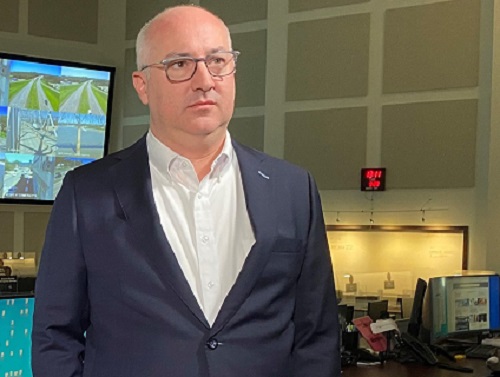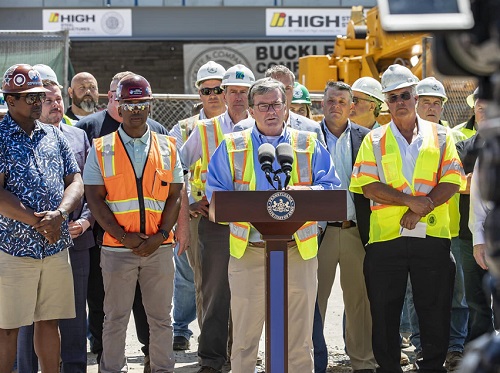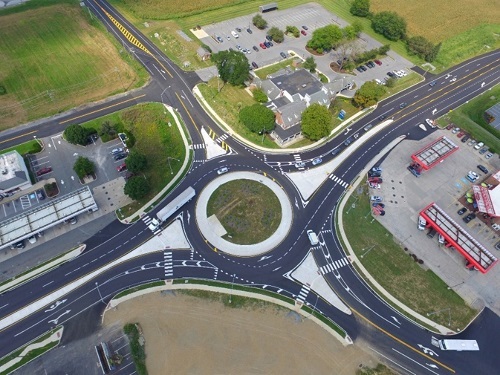State departments of transportation across the country recently recognized the critical role traffic roundabouts play in improving safety and travel conditions as part of the 2023 National Roundabouts Week campaign, which took place September 18-22.
[Above photo by PennDOT]
These circular intersections are gaining in popularity as a safer alternative to traditional stop-sign or signal-controlled intersections and are now considered one of the most effective ways to reduce intersection crashes and fatalities, according to Federal Highway Administration data.
“The data is there: Roundabouts can reduce crashes by 50 percent and reduce fatalities by 90 percent,” explained Brad White, executive director of the Mississippi Department of Transportation, in a statement.

“Along with the glaring safety benefits, they are also often more efficient than traditional intersections, reducing wait times and idling,” he added. “By participating in National Roundabouts Week, we aim to highlight these ongoing efforts to improve road safety and traffic management across the state.”
The Mississippi DOT noted that roundabouts are designed to reduce traffic congestion, minimize the risk of severe accidents and enhance the overall flow of traffic. This is achieved by requiring vehicles to slow down and enter the circular intersection, which eliminates high-speed, head-on collisions and reduces the severity of accidents.
“Mississippi DOT, like many road agencies and state DOTs, is embracing roundabouts as we recognize their potential to save lives,” White noted. “As we continue to invest in these innovative intersections, residents can look forward to safer roads, reduced congestion, and a brighter future for transportation in Mississippi.”
[Editor’s note: In the video below, Howard McCulloch with the New York State Department of Transportation discusses how roundabouts have proven to be a safer alternative to traffic signals and stop signs, generally safer for pedestrians, can improve traffic flow, and are better for the environment.]
Meanwhile, the Pennsylvania Department of Transportation recently released a detailed report showing how fatalities, injuries, and crashes decreased overall after intersections at 39 locations were replaced with 42 roundabouts.
The agency looked at 36 single-lane and six multi-lane roundabouts on state routes at intersections that were previously stop or signal controlled. This update to data released in 2022 now includes an additional seven roundabouts.

The department’s data from 2003 through 2022 obtained from police-submitted crash reports and weighted based on the number of before and after years but not for increases in traffic volume, shows that crashes involving suspected serious injuries were reduced by 24 percent; crashes involving suspected non-serious injuries were reduced by 51 percent; and the total number of crashes were reduced by 3 percent.
“PennDOT is continuing its work to identify and implement innovations and best practices across Pennsylvania,” noted PennDOT Secretary Mike Carroll. “I’m proud to see that the data on roundabouts remains consistent on saving lives and reducing crash severity.”
Other states are witnessing similar positive safety results with roundabouts. The Connecticut Department of Transportation has constructed 16 roundabouts across the state and has 14 more planned for state roadways in the future, noting that a study of five of those roundabouts found an 81 percent reduction in severe crashes and a 49 percent reduction in total crashes.
“I’m a strong advocate of roundabouts because they are proven to improve safety for all roadway users and reduce vehicle emissions polluting our air,” noted Connecticut DOT Deputy Commissioner Laoise King in a statement. “By converting intersections to roundabouts, motorist, bicyclist, and pedestrian safety is improved, and traffic congestion is reduced. We’ll continue building roundabouts where appropriate to ensure people reach their destination safely and efficiently every trip.”
 Nation
Nation
Registration Open for AASHTO’s Winter Rail Meeting
December 19, 2025 Nation
Nation

